RCA of Fuel Pump Failure
Root Cause Analysis (RCA) methodologies provide a systematic approach to understanding and resolving problems, such as fuel pump failures. We've employed fishbone and 5-why analyses to investigate the root causes of fuel pump failure, aiding in problem management and initiating corrective and preventive actions (CAPA). Leveraging ProSolvr, a powerful RCA tool for quality and reliability improvement, enhances the effectiveness of our analysis process.
Delving into the intricacies of a malfunctioning fuel pump through the comprehensive 5M 1E framework allows us to dissect and understand various factors contributing to the breakdown. By examining Manpower, Machines, Materials, Methods, Measurement, and Environment (5Ms 1E), we gain a holistic perspective on the root cause, enabling precise corrective and preventive actions (CAPA) and effective actions tracking
This structured approach not only pinpoints the immediate issue but also unveils underlying systemic problems, ensuring a thorough examination for robust quality and reliability outcomes. Moreover, integrating cause tree analysis enhances our understanding of interrelated causes, further refining our RCA process.
To illustrate this methodical approach, we've developed a visual fishbone map. This map serves as a navigational tool, guiding us through each element of the 5M 1E framework and showcasing how they interconnect in our RCA process. By following this map, we can systematically address each aspect, ultimately driving towards optimized performance and heightened reliability in our automotive systems.
The fishbone diagram simplifies root cause analysis by providing a visual representation of potential factors contributing to a problem, such as fuel pump failure in vehicles. It categorizes causes like manpower, methods, machines, materials, measurements, and environment, allowing for thorough exploration. This method uncovers deeper issues beyond immediate causes, aiding in effective solutions and enhancing problem-solving in the automotive industry.
Who should use the Fuel Pump Failure template?
Why use this template?








